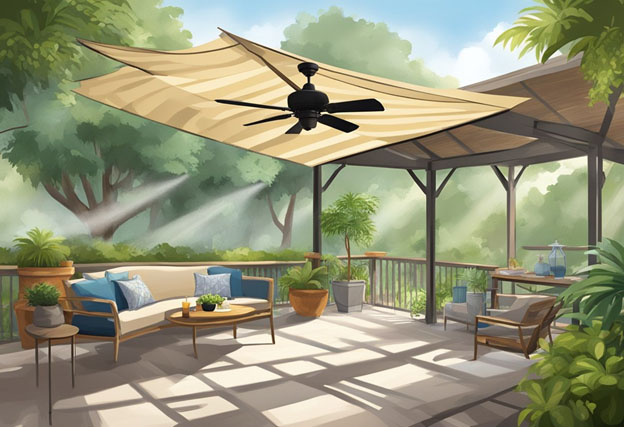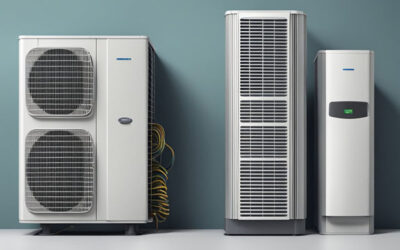As the summer months approach, many homeowners are looking for ways to keep their homes cool without relying solely on air conditioning. Not only can running the AC all day be expensive, but it can also have a negative impact on the environment. Fortunately, there are alternative ways to keep your home cool that are both cost-effective and eco-friendly.
One option is to install ceiling fans in your home. Ceiling fans can circulate air and create a cooling effect without using as much energy as an air conditioning unit. Additionally, they can be used in conjunction with your AC to help distribute cool air throughout your home more efficiently. Another option is to invest in window treatments that can block out the sun’s rays and keep your home cooler. This can include blackout curtains, shades, or blinds that are specifically designed to reduce heat gain.
By exploring alternative ways to keep your home cool, homeowners can save money on their energy bills while also reducing their carbon footprint. From ceiling fans to window treatments, there are a variety of effective and sustainable options available.
Natural Ventilation Strategies
When it comes to keeping your home cool, natural ventilation strategies can be an effective and eco-friendly alternative to air conditioning. By using natural air flow, you can reduce your energy consumption and save money on your electricity bill. Here are two popular natural ventilation strategies:
Cross Ventilation
Cross ventilation works by creating a flow of air through your home. This can be achieved by opening windows or doors on opposite sides of your home. The air will flow through your home, creating a cooling effect. To maximize the benefits of cross ventilation, it’s important to consider the placement of your windows and doors. For example, if you have windows on one side of your home but not the other, you may need to create additional openings to allow for air flow.
Stack Effect Ventilation
Stack effect ventilation works by creating a natural flow of air through your home. This is achieved by creating a temperature difference between the top and bottom of your home. Warm air rises, so if you can create a way for warm air to escape, it will draw cool air in from below. This can be achieved by opening windows or vents at the top of your home and allowing warm air to escape. Cooler air will then be drawn in from below.
Both cross ventilation and stack effect ventilation can be effective ways to keep your home cool without relying on air conditioning. By using these natural ventilation strategies, you can reduce your energy consumption and save money while still enjoying a comfortable living space.
Thermal Mass and Passive Cooling
Building Materials
One way to keep a home cool without air conditioning is to use materials with high thermal mass. Thermal mass refers to the ability of a material to absorb and store heat energy. When the temperature outside is cooler than the temperature inside, the thermal mass will absorb the heat from the air and keep the interior temperature stable.
Materials with high thermal mass include concrete, brick, stone, and tile. These materials can be used in walls, floors, and ceilings to help regulate the temperature inside the home.
Nighttime Purging
Another way to keep a home cool is through nighttime purging. This involves opening windows and doors during the cooler nighttime hours to allow cooler air to circulate throughout the home. This can be especially effective in areas where the temperature drops significantly at night.
To maximize the effectiveness of nighttime purging, it is important to create a cross-breeze by opening windows on opposite sides of the home. This will allow for maximum air flow and cooling.
Overall, using materials with high thermal mass and practicing nighttime purging can be effective ways to keep a home cool without relying on air conditioning.
Shading and Reflective Solutions
Window Treatments
Window treatments are a great way to reduce the amount of heat that enters your home. By using blinds, shades, or curtains, you can block out the sun’s rays and keep your home cool. For maximum effectiveness, choose window treatments that are light in color and have a reflective backing. This will help to reflect the heat away from your home.
Exterior Shading
Exterior shading is another effective way to keep your home cool. By using exterior shading devices such as awnings or pergolas, you can block the sun’s rays before they even reach your windows. This will help to reduce the amount of heat that enters your home. Additionally, exterior shading devices can add aesthetic value to your home and increase its curb appeal.
Roof Reflectivity
Roof reflectivity is an important factor to consider when trying to keep your home cool. By choosing a roofing material that has a high reflectivity, you can reduce the amount of heat that is absorbed by your roof. This will help to keep your home cool and reduce your energy bills. Additionally, a reflective roof can increase the lifespan of your roof by reducing the amount of heat that is absorbed by the roofing material.
Overall, shading and reflective solutions are effective ways to keep your home cool. By using window treatments, exterior shading devices, and a reflective roof, you can reduce the amount of heat that enters your home and increase your comfort during the hot summer months.
Landscaping for Cooling
Keeping your home cool during hot summer months can be a challenge, especially if you don’t want to rely solely on air conditioning. One alternative method to consider is landscaping for cooling. By strategically planting trees and incorporating green roofs and walls, you can significantly reduce the temperature in and around your home.
Strategic Tree Planting
Trees not only provide shade, but they also release moisture into the air through a process called transpiration. This can help cool the surrounding air by up to 6 degrees Fahrenheit. By planting trees strategically around your home, you can create a natural barrier that blocks the sun’s rays and reduces the amount of heat that enters your home.
Consider planting deciduous trees on the east and west sides of your home. These trees will provide shade during the summer months when the sun is high in the sky, but will allow sunlight to pass through during the winter months when the sun is lower in the sky. This will help keep your home cool in the summer and warm in the winter.
Green Roofs and Walls
Green roofs and walls are another effective way to keep your home cool. Green roofs are essentially gardens that are planted on top of your home, while green walls are vertical gardens that are attached to the exterior of your home. Both types of gardens provide insulation and shade, which can significantly reduce the amount of heat that enters your home.
Green roofs and walls also absorb and release moisture, which can help cool the surrounding air. They also provide a natural habitat for birds and insects, which can help promote biodiversity in your area.
In addition to keeping your home cool, green roofs and walls can also improve air quality, reduce stormwater runoff, and increase the lifespan of your roof by protecting it from the elements.
By incorporating strategic tree planting, green roofs, and walls into your landscaping, you can significantly reduce the amount of heat that enters your home and create a more sustainable living environment.
Evaporative Cooling Techniques
Direct Evaporative Cooling
Direct evaporative cooling is a simple and effective method of cooling your home. It works by using a fan to blow air over water-soaked pads or screens, which cools the air as it evaporates the water. This cooled air is then circulated throughout your home, providing relief from the heat.
One of the benefits of direct evaporative cooling is that it is an energy-efficient alternative to traditional air conditioning. It uses significantly less electricity and can reduce your energy bills by up to 75%. Additionally, it is a more environmentally friendly option, as it does not rely on harmful refrigerants.
Indirect Evaporative Cooling
Indirect evaporative cooling is another option for keeping your home cool. This technique uses a heat exchanger to cool the air, rather than directly cooling it with water. It works by circulating hot, dry air through a heat exchanger, where it is cooled by contact with a wet surface. The cooled air is then circulated throughout your home, providing relief from the heat.
One of the benefits of indirect evaporative cooling is that it can be used in areas with high humidity, where direct evaporative cooling is less effective. It is also an energy-efficient option, using up to 90% less electricity than traditional air conditioning.
Overall, evaporative cooling techniques provide an effective and energy-efficient alternative to traditional air conditioning. They can significantly reduce your energy bills and are more environmentally friendly.
High-Efficiency Fans and Ventilators
Ceiling Fans
Ceiling fans are a popular choice for homeowners looking to reduce their reliance on air conditioning. These fans work by circulating air in a room, creating a breeze that can help cool down the space. High-efficiency ceiling fans can be a great option for those looking to save on energy costs, as they use less electricity than traditional fans while still providing the same level of comfort.
When choosing a ceiling fan, it’s important to consider the size of the room and the height of the ceiling. A fan that is too small for the room will not provide adequate cooling, while a fan that is too large can be noisy and may cause discomfort. Additionally, fans should be installed at a height of at least 7 feet from the floor to ensure proper air circulation.
Whole House Fans
Whole house fans are another alternative to air conditioning that can be highly effective in certain climates. These fans work by pulling cool air into a home through open windows and exhausting hot air out through the attic. They can be particularly effective in areas with cool evenings and mornings, as they can help to bring in fresh air and cool down a home before the heat of the day sets in.
When choosing a whole house fan, it’s important to consider the size of the fan and the size of the home. A fan that is too small will not be able to effectively cool down the entire home, while a fan that is too large can be noisy and may cause discomfort. Additionally, whole house fans should be used in conjunction with proper ventilation and insulation to ensure maximum energy efficiency.
Dehumidification Strategies
Desiccant Dehumidifiers
Desiccant dehumidifiers are an effective way to remove moisture from the air in your home. They work by using a desiccant material, such as silica gel or activated alumina, to absorb moisture from the air. This type of dehumidifier is particularly useful in areas with high humidity levels, such as bathrooms, basements, and laundry rooms.
One of the benefits of desiccant dehumidifiers is that they can operate at lower temperatures than traditional refrigerant dehumidifiers. This makes them a good choice for use in cooler climates, where refrigerant dehumidifiers may not be as effective.
Ventilation Control
Another way to reduce humidity levels in your home is to control ventilation. This can be done by using exhaust fans in bathrooms and kitchens, or by opening windows and doors to allow fresh air to circulate.
In addition to reducing humidity levels, proper ventilation can also improve indoor air quality by removing pollutants and allergens from the air.
It’s important to note that ventilation control may not be as effective in areas with high outdoor humidity levels. In these cases, a combination of ventilation control and desiccant dehumidification may be necessary to maintain a comfortable indoor environment.
Overall, there are a variety of dehumidification strategies that can be used to keep your home cool and comfortable. By understanding the different options available, you can choose the best approach for your specific needs and preferences.
Smart Home Climate Systems
Smart home climate systems are becoming an increasingly popular alternative to traditional air conditioning systems. These systems use advanced technology to monitor and adjust the temperature and humidity levels in your home, helping you to stay comfortable and save energy at the same time.
Smart Thermostats
One of the most popular types of smart home climate systems is the smart thermostat. These devices use sensors to monitor the temperature in your home and adjust your heating and cooling systems accordingly. They can be programmed to turn on and off at specific times, and some models even learn your habits and adjust themselves automatically.
Smart thermostats can also be controlled remotely using a smartphone app, allowing you to adjust the temperature from anywhere. Some models even integrate with other smart home devices, such as voice assistants or security systems, to provide a seamless and convenient experience.
Energy Management Systems
Another type of smart home climate system is the energy management system. These systems use sensors and analytics to monitor your home’s energy usage and identify areas where you can save money. They can also adjust your heating and cooling systems to optimize energy efficiency, helping you to save money on your energy bills.
Energy management systems can also provide insights into your energy usage patterns, allowing you to make informed decisions about how to reduce your energy consumption and save money in the long run. Some models even integrate with renewable energy sources, such as solar panels, to further reduce your carbon footprint and energy costs.
Overall, smart home climate systems offer a convenient and energy-efficient alternative to traditional air conditioning systems. With a range of features and capabilities, they can help you to stay comfortable while saving money and reducing your environmental impact.
Alternative Energy Sources for Cooling
Solar Powered Air Conditioning
Solar-powered air conditioning is an excellent alternative to traditional air conditioning units. These systems use solar panels to generate electricity, which powers the air conditioner. Solar-powered air conditioning can be used in any climate, making it a great option for homeowners who want to reduce their carbon footprint and save money on their energy bills.
One of the main benefits of solar-powered air conditioning is that it is environmentally friendly. It does not emit any harmful pollutants, making it an excellent choice for homeowners who are concerned about the environment. Additionally, solar-powered air conditioning systems are very efficient, which means that they can save homeowners a lot of money on their energy bills.
Geothermal Cooling Systems
Geothermal cooling systems are another alternative to traditional air conditioning units. These systems use the earth’s natural heat to cool and heat a home. Geothermal cooling systems work by using a series of pipes that are buried underground. These pipes contain a liquid that absorbs heat from the earth. The liquid is then pumped into the home, where it is used to cool the air.
One of the main benefits of geothermal cooling systems is that they are very energy efficient. They use the earth’s natural heat, which means that they do not require as much electricity as traditional air conditioning units. Additionally, geothermal cooling systems are very quiet, making them an excellent choice for homeowners who want a quiet and peaceful home.
In conclusion, solar-powered air conditioning and geothermal cooling systems are excellent alternatives to traditional air conditioning units. They are environmentally friendly, energy-efficient, and can save homeowners a lot of money on their energy bills.





0 Comments